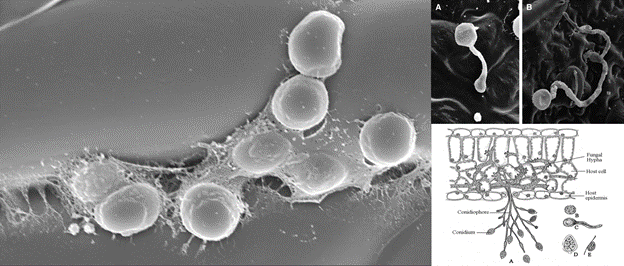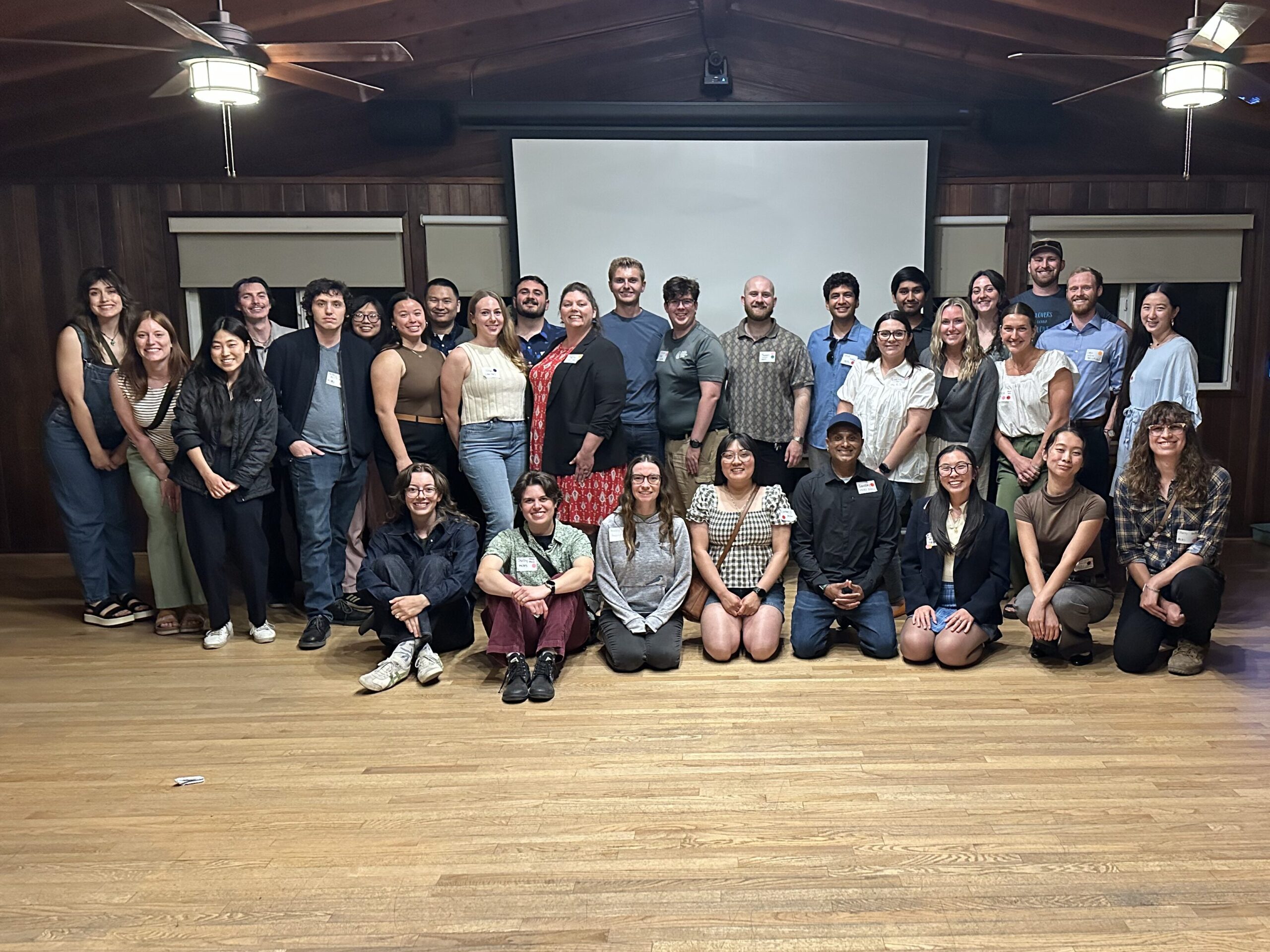Student Blog: Elias Potashov
Final Blog Post – Elias Potashov
Doing Science Whilst Living Through the Greatest Pandemic of Our Time
Life is a providential experience. The entirety of the 2019-2021 cohort of the MCRS program can attest to the massive hurdles caused by COVID-19, and I can personally speak from my experience on the Drought Net team that the chain of events leading up to the culmination of our research has been quite profound. I would like to introduce to you, the reader, some of my observations on the responses to COVID-19 and to the pathogenic genus of water molds known as Phytophthora. They are eerily similar to each other and tell us a lot about the brutal power of nature in our world.

| Figure 1: SARS-CoV-2 virus |
But first, I will point some minor differences between the two:
COVID-19 is a disease caused by the SARS-CoV-2 virus that causes complications that we are all, unfortunately, too accustomed to hearing about. As COVID-19 is caused by a virus, it is prone to frequent mutations inherent to virus-borne diseases. Phytopthora is a genus of water molds that cause a plethora of diseases in plants. Water molds will not mutate as fast as they have a significantly longer lifespan (Sierotzki, et al., 2010) whereas it is questionable if viruses are even alive or not. The etymology of Phytopthora quite literally breaks down to “Plant-Destroyer” (“Phytó” – “plant,” “Phthorá” – “destroy”). There are over 170 species of this type of pathogen, and some of the most prominent sicknesses are characterized as root and crown diseases, sudden oak death, blight, and fruit brown rot. It can even cause the damping-off of seedlings, stifling their growth (Erwin & Ribeiro, 1996). It may even act in such a capacity as to drive different successional patterns throughout the landscape. Phytophthora’s presence and the phenomena of cultivating monocultures of staple food crops are touted as the principal culprits in causing the Irish potato famine (Goss et al., 2014). And since the Drought Net Project is centered around the study of native plants from coastal and inland seed sources, plant pathogens were the last thing we wanted to encounter.

Figure 1: Physiology and sexual structures of Phytophthora
So, in addition to having to deal with COVID-19, we, the Drought Net group, learned in the very eventful year of 2020 that we were facing the risk of high mortality in our research plots associated with the possible presence of Phytophthora. We decided we needed to take as many preventative measures as possible to prevent further spread of this pathogen to limit any deleterious consequences in our research.

Figure 2: Drought Net Research Field Site at the UC-Irvine Natural Preserve
This also got us thinking about how this possible pathogen may be associated with the seldom studied phenomena of pathogen presence resulting in a mosaic of different plant types existing in a natural landscape, how some species may or may not be affected by Phytophthora or simply have not been exposed to it yet. Furthermore, the experimental design of our research plots is devised in a manner that mimics drought, high rain, and ambient hydrologic conditions. As Phytophthora is a water mold, and moisture gradients likely influence its motility throughout the landscape, this form of experimental design shines a light on the presence of this pathogen. The manipulated variables of the design may very well directly influence the presence and dispersal potential of this water mold. A perfect storm if you will.
We decided that we would test all of our field research site plots for this pathogen and map out the potential dispersal routes. We also decided to look back at previous year’s data to see if there is any correlation between the mortality of specific native plant species and the presence or absence of Phytophthora. We look forward to sharing our findings with you.

The following is a list of just some of the striking similarities between the two. Both SARS-CoV-2 and Phytophthora
- are dispersed throughout various environments by humans as their primary vectors.
- are spread by water droplets.
- can be found all across the world.
- lead to increased mindfulness of cross-contamination and contact tracing.
- lead to an increase in preventative measures such as repetitive cleaning, sterilizing, and minimizing exposure through quarantining procedures.
- lead to high mortality in organisms which can have severe economic and psychological ramifications.
- Led to the development of rapid testing technologies out of vital necessity.
If the past year has taught us anything about the world, it is that we should keep pushing forward no matter what obstacles come our way. From my 26 years on this Earth, I have realized that everything worthwhile in life is worth struggling for. Our minimum allotment of interns, cripplingly limited by restrictions surrounding COVID-19, hasn’t make things any easier. Nevertheless, working on this project has been an exciting and meaningful run so far. We have been well accustomed to regularly hearing different buzzwords like “sterilize,” “quarantine,” “testing,” on multiple fronts, and we will do our best to keep our chins up, stay on our toes, and stick it out until the end.
Our world is rapidly changing, and the findings of our research into seed sources could potentially be used to inform restoration practitioners about practices they should use for their restoration projects in the near future. The ramifications of getting these data are huge as the right seed source can determine how resilient certain plant species are to the extreme weather patterns that are becoming ever more common – plant species that are dominant cornerstones of most coastal sage scrub and chaparral plant communities in the Southwestern United States. It will take much more than a two-pronged assault from COVID-19 and Phytophthora to put an end to our work.
References:
Erwin, D. C., & Ribeiro, O. K. (1996). Phytophthora diseases worldwide. Phytophthora Diseases Worldwide. https://www.cabdirect.org/cabdirect/abstract/19971001256
Goss, E. M., Tabima, J. F., Cooke, D. E. L., Restrepo, S., Fry, W. E., Forbes, G. A., Fieland, V. J., Cardenas, M., & Grünwald, N. J. (2014). The Irish potato famine pathogen Phytophthora infestans originated in central Mexico rather than the Andes. Proceedings of the National Academy of Sciences, 111(24), 8791–8796. https://doi.org/10.1073/pnas.1401884111
Sierotzki, H., Blum, M., Olaya, G., Waldner-Zulauf, M., Buitrago, C., Wullschleger, J., Cohen, Y., & Gisi, U. (2011). Sensitivity to CAA fungicides and frequency of mutations in cellulose synthase (CesA3) gene of oomycete pathogen populations. Modern Fungicides and Antifungal Compounds VI. 16th International Reinhardsbrunn Symposium, Friedrichroda, Germany, April 25-29, 2010, 103–110.



